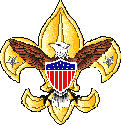| MERIT BADGES |
|
|
|
|
| Note: Eagle Required are in Italics |
"A"
American
Business
American Culture
American Heritage
American Labor
Animal Science
Archaeology
Archery
Architecture
Art
Astronomy
Athletics
Atomic Energy
Auto Mechanics
Aviation
"B"
Backpacking
Basketry
Bird Study
Bugling
"C"
Camping
Canoeing
Chemistry
Cinematography
Citizenship
Community*
Citizenship Nation*
Citizenship World*
Climbing
Coin Collecting
Collections
Communications*
Computers
Cooking
Crime Prevention
Cycling*
"D"
Dentistry
Disability Awareness
Dog Care
Drafting
"E"
Electricity
Electronics
Emergency
Preparedness**
Energy
Engineering
Entrepreneurship
Environmental
Science*
"F"
Family Life*
Farm Mechanics
Fingerprinting
Fire Safety
First Aid*
Fish & Wildlife Mgmt.
Fishing
Fly Fishing
Forestry
"G"
Gardening
Genealogy
Geology
Golf
Graphic Arts
"H"
Hiking
Home Repairs
Horsemanship
"I"
Indian Lore
Insect Studies
"J"
Journalism
"K"
"L"
Landscape Architecture
Law
Leatherwork
Lifesaving**
"M"
Mammal Study
Medicine
Metalwork
Model Design & Building
Motorboating
Music
"N"
Nature
"O"
Oceanography
Orienteering
"P"
Painting
Personal Fitness**
Personal Management*
Pets
Photography
Pioneering
Plant Science
Plumbing
Pottery
Public Health
Public Speaking
Pulp and Paper
"Q"
"R"
Radio
Railroading
Reading
Reptile & Amphibian Study
Rifle Shooting
Rowing
"S"
Safety
Salesmanship
Scholarship
Sculpture
Shotgun Shooting
Skating
Skiing
Small Boat Sailing
Soil & Water
Conservation
Space Exploration
Sports**
Stamp Collecting
Surveying
Swimming**
"T"
Textile
Theatre
Traffic Safety
Truck Transportation
"U"
"V"
Veterinary Medicine
"W"
Water Skiing
Weather
Whitewater
Wilderness Survival
Wood Carving
Woodwork
"X"
"Y"
"Z"
|
|
- Name four branches of oceanography. Describe at least five reasons why it is important for people to learn about the oceans.
- Define salinity, temperature, and density, and describe how these important properties of seawater are measured by the physical oceanographer. Discuss the circulation and currents of the ocean. Describe the effects of the oceans on weather and climate.
- Describe the characteristics of ocean waves. Point out the differences among the storm surge, tsunami, tidal wave, and title bore. Explain the difference between sea, swell, and surf. Explain how breakers are formed.
- Draw a cross-section of underwater topography. Show what is meant by:
- Continental shelf
- Continental slope
- Abyssal plains
Name and put on your drawing the following: seamount, guyot, rift valley, canyon, trench, and oceanic ridge. Compare the depths in the oceans with the heights of the mountains on land.
- List the main salts, gases, and foods in sea water. Describe the importance of these to life in the sea. What is meant by Dittmar's principle? Why is it important?
- Describe some of the biologically important properties of seawater. Define benthos, nekton, and plankton. Name some of the plants and animals that make up each of these groups. Describe the place and importance of phytoplankton in the oceanic food chain.
- Do ONE of the following:
- Make a plankton net. Tow the net by a dock, wade with it, hold it in a current, or tow
it from a rowboat. Do this for about 20 minutes. Save the sample. Examine it under a
microscope or high-power glass. Identify the three most common types of plankton in the
sample.
- May be done in lakes or streams.
- Make a series of models (clay or plaster and wood) of a volcanic island. Show the growth of an atoll from a fringing reef through a barrier reef. Describe the Darwinian theory of coral reef formation.
- Measure the water temperature 1 foot below the surface of a body of water four times
daily (8 a.m., noon, 4 p.m., and 8 p.m.) for 6 consecutive days. Measure the air
temperature. Note the cloud cover and roughness of the water. Show your findings on a
graph. Tell how the water temperature changes with air temperature.
- May be done in lakes or streams.
- Make a model showing the inshore sediment movement by littoral currents, tidal movement, and wave action. Include such formations as high and low waterlines, low tide terrace, berm, and coastal cliffs. Show how the offshore bars are built up and torn down.
- Make a wave generator. Show reflection and refraction of waves. Show how groins, jetties, and breakwaters affect these patterns.
- Make a plankton net. Tow the net by a dock, wade with it, hold it in a current, or tow
it from a rowboat. Do this for about 20 minutes. Save the sample. Examine it under a
microscope or high-power glass. Identify the three most common types of plankton in the
sample.
- Do ONE of the following:
- Write a 500-word report on any good book about oceanography approved by your counselor.
- Visit one of the following:
- an oceanographic research ship or
- an oceanographic institute.
Write a 500-word report about your visit.
- Explain to your troop in a 5-minute prepared speech "Why Oceanography Is Important" or describe "Jobs in Oceanography." (Before making your speech, show your speech outline to your counselor for approval.)
|
||||||
Last Update May 15, 2023

.jpg)

 Oceanography
Oceanography